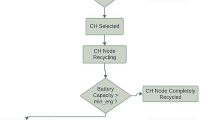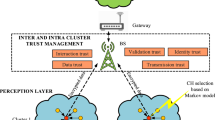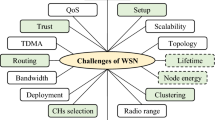Abstract
With the emergence of the Internet of Things (IoT) in recent years, the security has been significantly called more and more people’s attention on wireless communication between the devices and the human-beings, as well as the devices to devices. Smart home (SH), as a small-scale example of the smart application-based field, has benefited from the concept of IoT since it uses an indoor data-centric sensor network. In SH, routing schemes are widely utilized for data aggregation purposes. However, there are three main issues, which can considerably affect the current execution of routing protocol in SH: (1) lack of technical methods for precisely regional division of the network, (2) the difficulty of differentiating data among various functional regions, and (3) the vulnerability of network with advanced internal routing attacks. To address the aforementioned issues, in this paper, a two-layer cluster-based network model for indoor structured SH and a novel Beta-based trust management (BTM) scheme are proposed to defend various types of internal attacks by integrating the variation of trust value, threshold, and evaluation. The proposed structure forms a secure hierarchical routing protocol called SH-PCNBTM to effectively support the data transmission service in SH networks. The performance of SH-PCNBTM is thoroughly evaluated by using a set of comprehensive simulations. We will show that the proposed routing protocol not only ensures the even distribution of cluster-heads in each sub-region, but it also identifies and isolates the malicious sensor nodes accurately and rapidly compared with other trust-based hierarchical routing protocols.





















Similar content being viewed by others
References
Pascual Espada, J., Yager, R. R., & Guo, B. (2014). Internet of things: Smart things network and communication. Journal of Network and Computer Applications, 42(3), 118–119.
Yang, Z., Yue, Y., Yang, Y., Peng, Y., Wang, X., & Liu, W. (2011). Study and application on the architecture and key technologies for IOT. In International conference on multimedia technology (ICMT) (pp. 747–751). IEEE.
Tan, J., & Koo, S. G. (2014). A survey of technologies in internet of things. In International conference on distributed computing in sensor systems (DCOSS) (pp. 269–274). IEEE.
Cao, B., Ge, Y., Kim, C. W., Feng, G., Tan, H. P., & Li, Y. (2013). An experimental study for inter-user interference mitigation in wireless body sensor networks. IEEE Sensors Journal, 13(10), 3585–3595.
Memon, I., Hussain, I., Akhtar, R., & Chen, G. (2015). Enhanced privacy and authentication: An efficient and secure anonymous communication for location based service using asymmetric cryptography scheme. Wireless Personal Communications, 84(2), 1487–1508.
Memon, I. (2015). Authentication user’s privacy: An integrating location privacy protection algorithm for secure moving objects in location based services. Wireless Personal Communications, 82(3), 1585–1600.
Memon, I. (2018). Distance and clustering-based energy-efficient pseudonyms changing strategy over road network. International Journal of Communication Systems. https://doi.org/10.1002/dac.3704.
Islam, K., Shen, W., & Wang, X. (2012). Security and privacy considerations for wireless sensor networks in smart home environments. In 16th international conference on computer supported cooperative work in design (CSCWD) (pp. 626-633). IEEE.
Huang, X., & Sharma, D. (2012). Resiliency controlling of wireless sensor networks for the protecting from internal attacks. In 26th International Parallel and Distributed Processing Symposium Workshops and PhD Forum (IPDPSW) (pp. 1256-1262). IEEE.
Yu, Y., Li, K., Zhou, W., & Li, P. (2012). Trust mechanisms in wireless sensor networks: Attack analysis and countermeasures. Journal of Network and computer Applications, 35(3), 867–880.
Heinzelman, W. B., Chandrakasan, A. P., & Balakrishnan, H. (2002). An application-specific protocol architecture for wireless microsensor networks. IEEE Transactions on Wireless Communications, 1(4), 660–670.
Li, Y., Yu, N., Zhang, W., Zhao, W., You, X., & Daneshmand, M. (2011). Enhancing the performance of LEACH protocol in wireless sensor networks. In IEEE conference on computer communications workshops (INFOCOM WKSHPS) (pp. 223–228). IEEE.
Arain, Q. A., Uqaili, M. A., Deng, Z., Memon, I., Jiao, J., Shaikh, M. A., et al. (2017). Clustering based energy efficient and communication protocol for multiple mix-zones over road networks. Wireless Personal Communications, 95(2), 411–428.
Zhou, W., Yuan, C., & Ling, Y. (2016). Improved LEACH algorithm for smart home controller. Journal of Computational Methods in Sciences and Engineering, 16(1), 39–47.
Tumer, A. E., & Gunduz, M. (2014). An improved leach protocol for indoor wireless sensor networks. In International conference on signal processing and integrated networks (SPIN) (pp. 432–437). IEEE.
Xu, Y., Wu, S., Tan, R., Chen, Z., Zha, M., & Tsou, T. (2013). Architecture and routing protocols for smart wireless home sensor networks. International Journal of Distributed Sensor Networks, 9(1), 89–108.
Ganeriwal, S., Balzano, L. K., & Srivastava, M. B. (2008). Reputation-based framework for high integrity sensor networks. ACM Transactions on Sensor Networks (TOSN), 4(3), 15.
Fang, W., Zhang, C., Shi, Z., Zhao, Q., & Shan, L. (2016). BTRES: Beta-based trust and reputation evaluation system for wireless sensor networks. Journal of Network and Computer Applications, 59, 88–94.
Geetha, V., & Chandrasekaran, K. (2013). Enhanced beta trust model for identifying insider attacks in wireless sensor networks. International Journal of Computer Science and Network Security (IJCSNS), 13(8), 14.
UmaRani, V., Sundaram, K. S., & Jayashree, D. (2016). Enhanced Beta Trust Model in wireless sensor networks. In 2016 International conference on information communication and embedded systems (ICICES) (pp. 1–5). IEEE.
Song, F., & Zhao, B. (2008). Trust-based LEACH protocol for wireless sensor networks. In 2nd international conference on future generation communication and networking (Vol. 1, pp. 202–207). IEEE Computer Society.
Wang, W., Du, F., & Xu, Q. (2009). An improvement of LEACH routing protocol based on trust for wireless sensor networks. In International conference on wireless communications, networking and mobile computing (pp. 1–4). IEEE.
Zhan, G., Shi, W., & Deng, J. (2012). Design and implementation of TARF: A trust-aware routing framework for WSNs. IEEE Transactions on Dependable and Secure Computing, 9(2), 184–197.
Ma, L., & Liu, G. (2015). A hierarchical trust model for cluster-based wireless sensor network. In International conference on control, automation and information sciences (pp. 337–342). IEEE.
Basan, A., Basan, E., & Makarevich, O. (2016). Development of the hierarchal trust management system for mobile cluster-based wireless sensor network. In 9th international conference on security of information and networks (pp. 116–122). ACM.
Huang, M., Bai, E., Jiang, X., & Wu, Y. (2016). An improved algorithm of LEACH protocol based on node’s trust value and residual energy. In International conference on geo-informatics in resource management and sustainable ecosystems (pp. 101–109). Singapore: Springer.
Cook, D. J. (2012). Learning setting-generalized activity models for smart spaces. IEEE Intelligent Systems, 27(1), 32–38.
Josang, A., & Ismail, R. (2002). The beta reputation system. In 15th bled electronic commerce conference (Vol. 5, pp. 2502–2511).
Savchuk, V., & Tsokos, C. P. (2011). Bayesian theory and methods with applications (Vol. 5, pp. 30–31). Paris: Springer.
Sabor, N., Sasaki, S., Abo-Zahhad, M., & Ahmed, S. M. (2016). A graphical-based educational simulation tool for wireless sensor networks. Simulation Modelling Practice and Theory, 69, 55–79.
Masdari, M., Bazarchi, S. M., & Bidaki, M. (2013). Analysis of secure LEACH-based clustering protocols in wireless sensor networks. Journal of Network and Computer Applications, 36(4), 1243–1260.
Broch, J., Maltz, D. A., & Johnson, D. B. (1999). Supporting hierarchy and heterogeneous interfaces in multi-hop wireless ad hoc networks. In International Symposium on Parallel Architectures, Algorithms and Networks (pp. 370–375). IEEE.
Acknowledgements
This work is supported by the National Natural Science Foundation of China under Grant Nos. 61304256 and 51708487, Zhejiang Provincial Natural Science Foundation of China (LQ16E080006), Zhejiang Province Public Technology Project (2017C33153, LGF18F010008), Young Researchers Foundation of Zhejiang Provincial Top Key Academic Discipline of Mechanical Engineering and Zhejiang Sci-Tech University Key Laboratory (ZSTUME01B15), New Century 151 Talent Project of Zhejiang Province, 521 Talent Project of Zhejiang Sci-Tech University, and Young and Middle-aged Talents Foundation of Zhejiang Provincial Top Key Academic Discipline of Mechanical Engineering.
Author information
Authors and Affiliations
Corresponding author
Rights and permissions
About this article
Cite this article
Hong, Z., Shao, Q., Liao, X. et al. A secure routing protocol with regional partitioned clustering and Beta trust management in smart home. Wireless Netw 25, 3805–3823 (2019). https://doi.org/10.1007/s11276-018-01916-1
Published:
Issue Date:
DOI: https://doi.org/10.1007/s11276-018-01916-1




